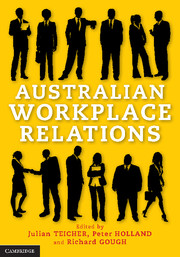 It is common for industrial relations to be written about without any mention or serious analysis of occupational health and safety (OHS). But a new textbook on Australian industrial relations includes a very good chapter of OHS that, significantly, cross-references other chapters in the book to provide a unified approach that reflects both the title and its intent. The book is called “Australian Workplace Relations” and the workplace health and safety chapter is written by Elsa Underhill.
It is common for industrial relations to be written about without any mention or serious analysis of occupational health and safety (OHS). But a new textbook on Australian industrial relations includes a very good chapter of OHS that, significantly, cross-references other chapters in the book to provide a unified approach that reflects both the title and its intent. The book is called “Australian Workplace Relations” and the workplace health and safety chapter is written by Elsa Underhill.
Underhill has written on the OHS effects of precarious employment extensively and this issue is the basis of her chapter. She sees this as major cause of many of the OHS issues, particularly the growth in psychosocial risks in modern society and provides copious amounts of Australian and international research in support.
The challenge she presents to the OHS professional is how to address the source of the hazards when the source is so complex and so big. Underhill does not advocate this but it is difficult to see change occurring without increased political activism on the part of the OHS profession and its members. If economic policies increase job insecurity and job insecurity leads to mental health issues for workers, as Underhill’s chapter explains, then OHS professionals must educate themselves in these policies and advocate alternatives that minimise or eliminate mental health impacts.
The attraction of this book is the clever editing and planning that interweaves themes throughout the chapters. Reading Underhill’s chapter on OHS lead me to an earlier chapter on “The dynamics of employee in Australia” by Amanda Pyman, Peter Holland, Julian Teicher and Brian Cooper. The authors describe the employee voice as
“… how employees raise concerns, express and advance their interest, opinions and ideas, solve problems, and contribute to and participate in workplace decision-making with management.” (page 119)
It is hard to see how this concept could not apply to OHS and the legislative requirements to consult. Similarly the employee voice needs an audience and, perhaps, a hallmark of a workplace safety culture could be the effective listening of an organisation.
The content is very current with discussion that includes the decline of worker involvement in OHS and behaviour-based approaches to OHS. Underhill quotes Shaw and Blewett from 2000 on the latter issue and shows that the inadequacies of behaviour-based safety was very evident over a decade ago:
“…resurgence of worker behaviour as a sufficient explanation for occupational ill-health and as the most effective target for interventions to improve OHS … [is depriving] workers of the poer to act on their environment, only on their behaviour.” (page 202)
Underhill goes on to discuss the “careless worker” syndrome but says
“…research has found consistently that collective worker involvement is essential to the development of a safe and healthy workplace; that effective OHS is not the domain of experts (although the input is necessary); and that a safe workplace is an outcome of deliberate actions by both management and workers.” (page 203)
In the context of various current and upcoming Government inquiries it is useful to remember that
“Legislative support for OHS worker representation is thus insufficient when institutional and political settings are hostile to unionisation and worker involvement.” (page 205)
And Underhill concludes the chapter with:
“There is a need to reconsider the economic and social benefit of ‘workplace flexibility’ when the health effects are so pervasive.” (page 207)
A noticeable difference in this chapter to the others is the lack of a case study but an OHS chapter does not really allow for such things and case studies often come from prosecutions which can eat up a lot of book space for limited benefit.
Underhill’s OHS chapter is not intended as an exhaustive analysis of OHS as this would justify a book in itself. However her chapter provides considerable detail and sources of evidence in a clear style missing from many other works on the matter. The extensive research base helps but data is not information and Underhill provides a great deal of information in a chapter of less than thirty pages. Australia needs more textbooks like this.
Note: SafetyAtWorkBlog was provided with a review copy of the book.

Obviously a book never read by Qld LNP given their proposals for amendments to Qld OH&S Legislation….
Sounds like a good read Kevin. Where can you get it?